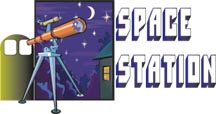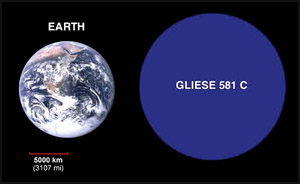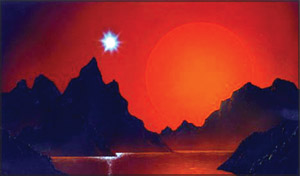|
Gliese 581c
A new Earth-like planet?
 Aliens,
outer space and life on other planets have fascinated most of us over
the years. Just remember how Aliens,
outer space and life on other planets have fascinated most of us over
the years. Just remember how
you gazed at the night sky and wished that you could soar off
and live on one
|

An artist’s view of the planet |
of the millions of stars or planets which you can see
glimmering hundreds and thousands of light years away? A recent
discovery in space exploration has shed some light on making this simple
dream of yours a reality some day. The information
|

A size comparison of Earth and the new planet |
surrounding it is simply amazing! Let's go into more details about
this new discovery. The search for habitable (livable) regions was
mainly focused on our solar system. But, for the first time, space
scientists have found a potentially habitable planet outside our solar
system, which has temperatures like our Earth and this is considered as
a great breakthrough in the search for 'life in the universe'. This
planet was discovered by a team of the Geneva Observatory in
Switzerland, and it was announced on April 24, 2007. This was done using
the European Southern Observatory's telescope in La Silla, Chile, which
has a special instrument that splits light to
|

The Gliese system with 581b, 581c and 581d |
find shapes in different wave lengths. The planet which is named
Gliese 581c, orbits the 'red dwarf star' Gliese 581 like the Earth
orbits the Sun. Until now, 220 planets which astronomers have found,
have the 'Goldilocks Problem'. That is either they are too hot, too
cold, just gaseous and so on. But, this new discovery seems just right. But, before you dream of going there, here
are some weird and also exciting experiences that you may encounter up
there. You will suddenly feel heavier and you will have a great sight of
the sky. The newly discovered planet is 14 times closer to the star it
revolves around, which means the 'red dwarf star' is twenty times larger
than our Moon! Girls won't like this planet much because the birthdays
are going to add up pretty fast since the planet orbits its star every
thirteen days! All this sounds really thrilling and it is indeed a
fascinating discovery. But, thousands of questions are yet to be
answered if this is going to be another Earth to us. Travelling this
distance in a human lifetime alone is one such problem!
discovery seems just right. But, before you dream of going there, here
are some weird and also exciting experiences that you may encounter up
there. You will suddenly feel heavier and you will have a great sight of
the sky. The newly discovered planet is 14 times closer to the star it
revolves around, which means the 'red dwarf star' is twenty times larger
than our Moon! Girls won't like this planet much because the birthdays
are going to add up pretty fast since the planet orbits its star every
thirteen days! All this sounds really thrilling and it is indeed a
fascinating discovery. But, thousands of questions are yet to be
answered if this is going to be another Earth to us. Travelling this
distance in a human lifetime alone is one such problem!
***
Physical
characteristics of Gliese 581c
* Mass
The calculation of the mass of the planet has been done depending on
the other planets that belong to the Gliese 581c system and on the
inclination of the orbital plane with respect to us. However,
considering the mass of Gliese 581b which astronomers have previously
found, and the assumed mass of the Gliese 581d, the mass of Gliese 581c
is estimated as 5.03 times that of Earth.
* Distance
Astronomically speaking, this planet is close to us. It is 20.5 light
years far from Earth. In more familiar terms, it is at 194 trillion km
or 120 trillion miles from Earth.
* Size
It is still not certain whether this is a rocky planet or a frozen
ice ball, and estimating the size depends on these.
However, if it is thought as a rocky planet, it has a radius 50 per
cent greater than Earth. If it is to be an icy or watery planet, the
radius would be even bigger, but less than twice the size of Earth.
* Gravity
Again, this is dependant on the nature of the planet. If rocky,
gravity is expected to be 2.2 times the Earth's gravity and if
otherwise, it would be around 1.25 times the Earth's gravity. So, if it
is rocky, a person weighing 100 pounds on Earth would weigh 220 pounds
over there!
* Age
The Gliese 581 system is estimated to be 4.3 billion years old. For
comparison, our solar system is considered 4.57 billion years old.
* Temperature
The research team believes the average temperature to be somewhere
between 32 and 104 degrees Fahrenheit and that set off celebrations
among astronomers. But what's in its atmosphere is still unknown and if
it's too thick, that could make the planet's surface temperature too
hot.
* Liquid water
This is the most important topic when it comes to habitability.
Liquid water could exist on the planet since it is in the 'habitable
zone' of the space around the star. But, there is no direct evidence
yet.
***
Fast facts - Red dwarf stars
You may be wondering what a 'red dwarf star' is. These stars are low
energy, tiny stars that give a dim red light.
Therefore, they are cooler compared to our Sun and they last longer
than stars like our Sun. They have a surface temperature of less than
3,500 Kelvins. Our Sun has a surface temperature of around 5,500 Kelvins.
Until this discovery, astronomers had not believed that red dwarfs could
have conditions suitable for human living.
About 80 per cent of the stars near Earth are said to be red dwarfs.
Compiled by Aravinda Dassanayake |
